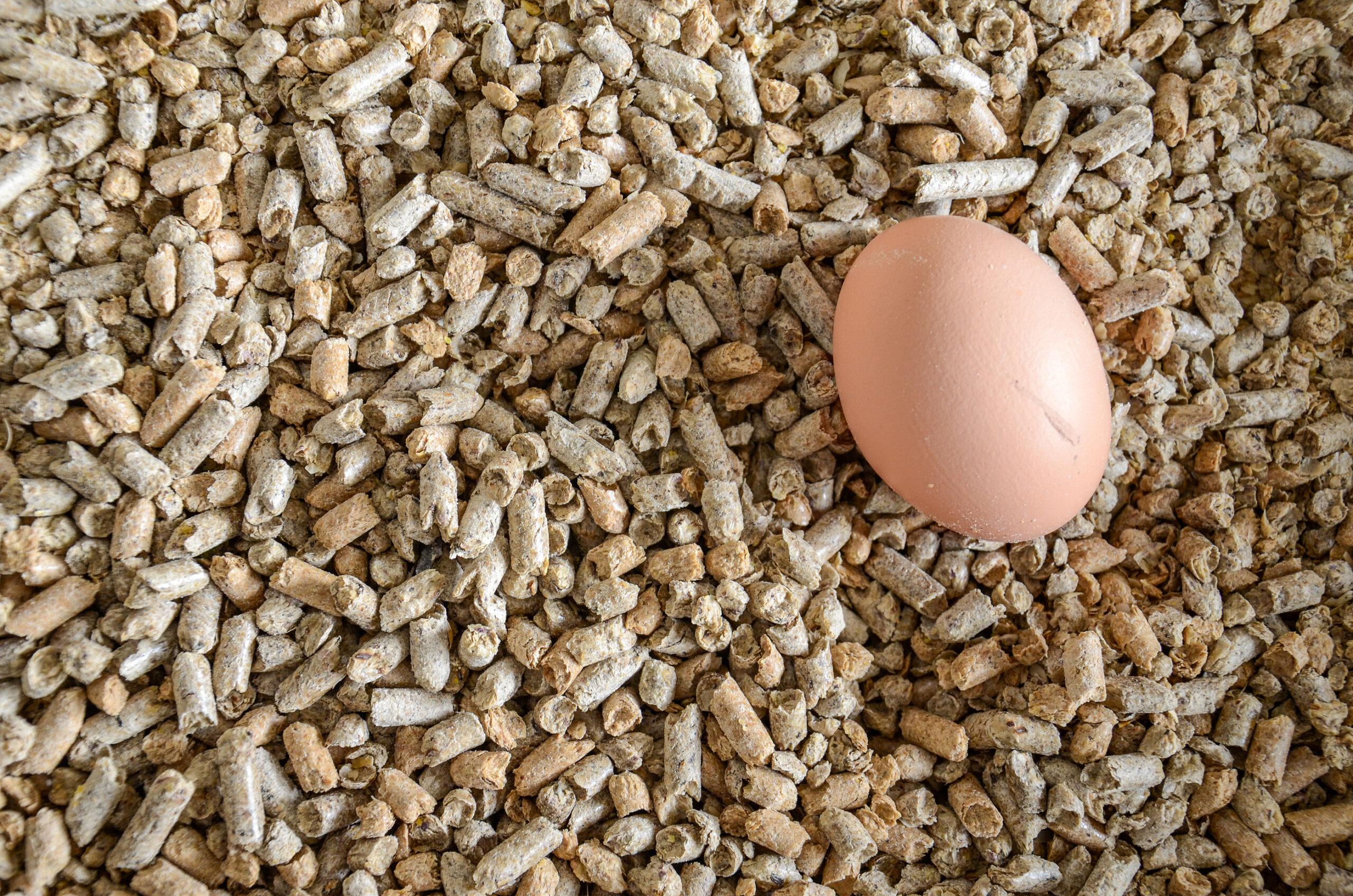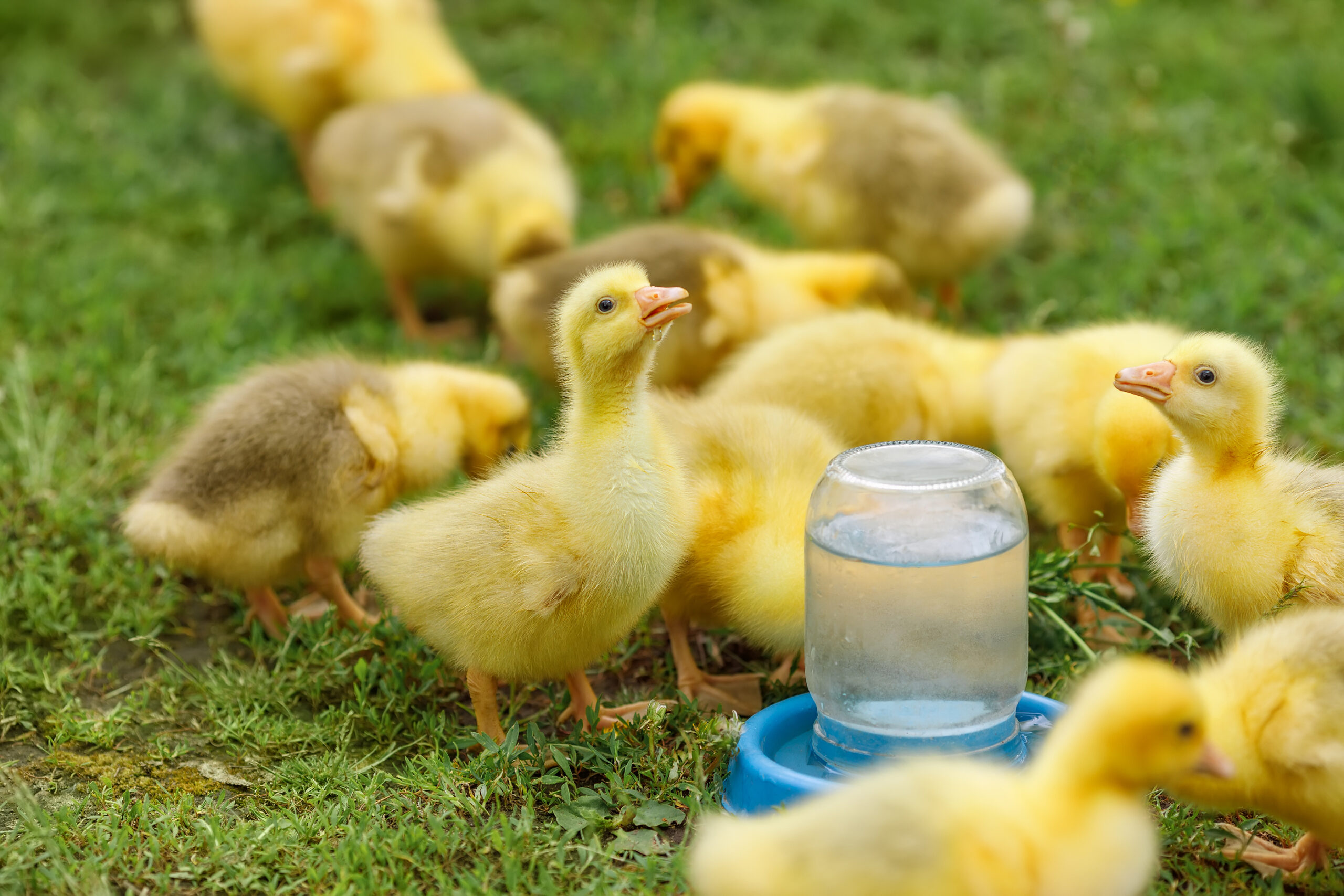Feed and Water Management
This article on feed and water management is an excerpt from the Small Flock Poultry Health Manual published by the Province of B.C. Ministry of Agriculture. The full manual can be accessed by clicking here.
Feed is a major expense in livestock production. Birds require carbohydrates, protein, fats, vitamins, minerals, and water. Nutrients offered above a maintenance level are used for growth in young birds and egg production in adult birds. How we provide these very important nutrients to our birds is critical in maintaining healthy and productive animals. Good quality feed and water is paramount in producing a flock that will deliver optimum performance.
Feed should be selected based on the age of the birds and the activities which they will perform (egg production, growth, racing, hunting/release, etc.). Specially formulated feeds offer the nutrients needed for these specific activities. Specific vitamins that need to be supplemented in a diet include vitamin A, D3, B12, riboflavin, pantothenic acid, niacin, folic acid, thiamine, selenium, and biotin. Critical minerals including: calcium, phosphorus, sodium, chlorine, magnesium, potassium, etc. may need to be supplemented as well if the raw ingredients in the diet do not contain sufficient levels. Common ingredients used in manufacturing a complete feed include: corn, wheat, wheat-by-products, barley, soybean, soybean meal, flax, canola meal, bakery-by-products, etc. By-products of animal origin (poultry fat, meat meal, blood meal, meat and bone meal and tallow) are now very seldom used.
In commercial poultry production, feeds can come in the form of a mash, a pellet (also extruded pellets), or a crumble. A mash or crumble feed is generally fed to young birds. Pellets are meant for larger birds. Feeds are also formulated based on the age and production status of the bird. In general, younger birds need higher protein levels. Once the birds organs and skeleton have reached full size, protein levels are decreased. As birds grow older and go into egg production, the nutrient needs are again reviewed to address the additional physiological requirements.

In the game bird industry, nutrient requirements have not been well established because of the variation in the type of markets that they cater to. Diets that have been formulated for commercial turkeys have been used with some success. Additional feeds can be given to birds to supplement their requirements and provide variety. These supplements may be plants or weeds, seeds, grains, fruits, and nuts. It is important to be aware of the management style for your class of bird and always take this into consideration when selecting a feed.
Feed should always be fresh. Old or spoiled feed may cause illness in birds. Periodically check the quality of the feed, paying attention to color, texture, and smell. Clean up spilled feed around the feed bin and surrounding feeders as this will be an attraction for moulds, rodents, and other vermin. Keep a record of the feed that has been fed to your birds and collect a sample from each batch in case a feed problem ever occurs. The feed sample should be placed in a sealed bag that is properly labeled with the date and batch number and stored in a freezer.
Additional information on feed rations for different types of birds is available in the book Commercial Poultry Nutrition, third edition, by Dr. Steve Leeson and Dr. John D. Summers. (Mention of specific sources of information is not intended to be an endorsement on feed and water management advice)
Water
Good quality water is vital for keeping your birds healthy. Water makes up about 70% of a bird’s body weight and on a daily basis, birds will drink at least twice the volume of water compared to the amount of food they consume.
Factors that affect water quality
Everyone who raises livestock or poultry should check the quality of the drinking water regularly. Water that comes from surface sources may contain pathogens or chemicals from runoff. Even water coming from deep wells can change in quality from season to season. Knowing the quality of your water by monitoring different parameters can aid in diagnosing bird health or management problems. Water should be tested a minimum of once a year.
Bacteria Level
Water is usually analyzed for total bacteria and total coliforms (E. coli is used as the indicator). The level considered ideal for both tests is zero CFU/ml (Colony Forming Units of bacteria per milliliter of water). However, the maximum acceptable levels are 100 CFU/ml total bacteria and 50 CFU/ml total coliforms. The presence of coliform bacteria in the water means that it has been contaminated with fecal materials. If the water supply is contaminated, measures should be initiated to treat it.
- Check the water source making sure that it is protected from surface drainage, sewage problems, and surface application of manure. If it is a well, make sure that well casings and general construction of the well head is sound.
- Contaminated water can be treated using appropriate filtration or a sanitizing chemical like chlorine, iodine, or hydrogen peroxide. Chlorine levels should be maintained at 1 ppm (parts per million) while hydrogen peroxide’s recommended level is 30 ppm. Higher than the recommended levels may cause toxicity or water refusal from birds
- Drinkers should be cleaned regularly to get rid of slime, calcium deposit, and accumulated organic materials.
Minerals
Calcium, chloride, copper, iron, lead, manganese, nitrate, sulfate, zinc, and sodium should all be tested. Birds may not experience serious health problems with higher levels of certain minerals. For example, high levels of calcium will not be absorbed and will be passed out of the bird in the feces. However, certain minerals in water, when combined with the same mineral in a balanced feed ration can potentially cause problems. For example, combined levels of sodium may result in increased water consumption, wet bedding and loose stool. If using automatic drinkers, clean calcium and biofilms from the water lines. Acidifiers have been used effectively in the commercial industry for this purpose.
Iron and manganese give a bitter metallic taste and iron also supports the growth of bacteria like E. coli and Pseudomonas sp. Iron, manganese, and sulfur will produce a rotten-egg smell. Chlorination and filtration will alleviate these problems. Chlorine also reduces the oxidation of iron and can therefore prevent the development of rust. The level of calcium and magnesium will determine water hardness. This causes the build-up of scale and sludge that can reduce pipe volume and negatively impact cleaners and disinfectants. Softeners can be used to reduce this problem.

Water pH
pH is measured on a scale of 1-14 with 7 being neutral. Anything below 7 is acidic and intensifies as it gets closer to 1 while anything above 7 is alkaline (basic). Drinking water pH should be close to the neutral level or slightly acidic. A basic water pH level will make chlorination ineffective. On the other hand, very acidic water can be corrosive and unpalatable for birds. Recent studies have shown that acidifying water (using organic and/or inorganic acids) to a pH of 4-6 may provide beneficial protection against bacteria in the digestive tract. You can safely add a small amount of apple cider vinegar to your water to achieve this effect.
Key Points to Remember on Feed and Water Management
- Fresh, properly balanced complete feeds should be the target. The use of scratch grains as a supplement will dilute the nutrient content of the ration.
- Fresh potable water should be always available to your birds.
- Test your water at least once a year for bacteria levels, mineral levels and pH and treat if necessary.
- If you are going to acidify and sanitize your water, use the acidifier first.
- Do not mix chlorine and acid as this will result in the release of dangerous chlorine gas.
- Do not mix vaccines intended for water application with chlorinated water as the chlorine will neutralize the vaccine. Skim milk can be added to water (91 grams per 38 liters of water) to neutralize sanitizers.
Take Home Message on Feed and Water Management
Feed and water quality and delivery are very important for all types of birds. Providing the right feed to address the needs of the birds as they grow can make a big difference in their over-all health and performance. Clean, wholesome water promotes optimal performance and prevents many health concerns. Proper monitoring, cleaning, and sanitation are required to maintain water quality. Lastly, ensure that feed and water are always available.
Suggested References for Feed and Water Management
Additional information on water quality, cleaning and sanitizing:Hydrogen Peroxide in Drinking Water: http://www.poultryindustrycouncil.ca/factsheets/fs_12.html
What is the Quality and Safety of Ontario Farm Drinking Water: http://www.poultryindustrycouncil.ca/factsheets/fs_37.pdf
Water Quality: An Important Consideration: http://www.poultryindustrycouncil.ca/factsheets/fs_65.pdf
Water Sanitation: http://www.poultryindustrycouncil.ca/factsheets/fs_85.pdf
Water Quality for Poultry: http://www.poultryindustrycouncil.ca/factsheets/fs_111.pdf
Avian Advice: Index for all concerns: http://www.poultryscience.uark.edu/avianindex.html
Poultry Nutrition: http://www.omafra.gov.on.ca/english/livestock/poultry/facts/introduction.htm
Water Safety: Putting your well water to the test. http://www.health.gov.on.ca/english/public/pub/watersafe/watersafe_welltest.html
This feed and water management article by:
Dr. Bruce Hunter, Ashley Whiteman, Dr. Babak Sanei, Al Dam and Dr. Teresa Cereno
University of Guelph and Ontario Ministry of Agriculture, Food, and Rural Affairs
